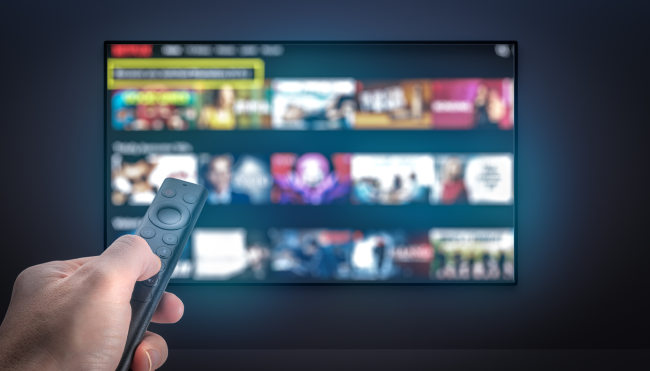- Why Amagi
-
Solutions
Contact UsBusinessWho We Serve
- Offerings
- AI
-
Resources
Contact UsINDUSTRY REPORTSAmagi FAST Report #15: The Power of Live Programming: A Catalyst for Streaming SuccessAugust 21, 2025Read More
-
Company
Contact UsNewsroomAmagi launches AI-powered Smart Scheduler to improve content programmingApril 3, 2025Read More
Blog
SXSW 2024: Q&A on new media and the future of storytelling
By The Editorial Team, - March 28, 2024
This month, Amagi’s Co-founder and CRO Srini KA joined Evan Shapiro and Future Media Hubs at SXSW in Austin, Texas, to discuss New Media Experiences: The Future of Storytelling and Monetization. Joining him on the panel were industry experts Linette Zaulich (ZDF Studios), David Freeman (CAA) and Sten-Kristian Saluveer (Storytek Innovation & Venture Studios, Cannes Next).
Panelists discussed how to navigate today’s media landscape, monetization and what the future holds. Here’s what they had to share.
Answers have been edited and condensed for clarity and length.
Sten-Kristian Saluveer, CEO at Storytek Innovation & Venture Studios, Head of Cannes Next: How do you navigate today’s media landscape for storytelling and monetization, and what are the key indicators in terms of the markets?
David Freeman, Co-Head of Digital Media at CAA: 2023 was a wild ride as it related to just, you know, the strikes … And you think about the pandemic, you think about the last five years of what's happening inside of the media landscape. And it's quite a massive 180. I think what you're going to see over the next 24 months is a continuation of that. I mean, the way that, you know, Gen-Z is consuming media versus the way that Gen X or baby boomers are is so different. And so what you're seeing is a lot of traditional media who's trying to embrace a lot of the creator economy mindset.
And while disruption can be tricky for some folks, especially for our legacy TV and film businesses in my world, in digital, there's nothing but opportunity.
So you just have to be able to capitalize on that opportunity when there is so much disruption. But I think it's going to continue to evolve. And I think every 12 or 18 months we're going to keep having different answers to this question. So for me, it's exciting.
So you just have to be able to capitalize on that opportunity when there is so much disruption. But I think it's going to continue to evolve. And I think every 12 or 18 months, we're going to keep having different answers to this question. So for me, it's exciting.
Srinivasan KA, Co-founder & CRO, Amagi: If we think about 2023, I think for me, the big transformative change was that a lot of streamers, a lot of content companies went from being exclusive -- having all their content in their SVOD app -- to becoming a lot more non-exclusive, looking at third parties for distribution. Netflix started doing non-exclusive licensing of content.
Disney, after saying, 'Hey, I'm going to pull out from Netflix,' started licensing to Netflix. If you look at pretty much every major content house, they saw the need to go beyond their own direct-to-consumer app to third parties for distributing their content. That could be SVOD, that could be AVOD, that could be FAST. Of course, linear has always been a third-party distribution.
So, in that sense, I think in 2024, a lot of it is going to be leveraging the content to get to as many audiences as possible. I think content's natural state is ubiquity rather than actually restricting it to just your own app, being able to make it available in everybody's app if possible. That would be really, really good for the audience and really good for the content owners.
And, of course, FAST, which is where [Amagi] plays a really large role, has been growing massively. It's been one of the fastest growing segments within the media industry, growing at 20% plus.
What metrics are the north star metrics that we actually look at for something like FAST?
First, am I growing the number of monthly active users year on year, month on month? If you look at today from a state of FAST perspective, more than 50% of people on average (US audience) watch FAST at least once. So the reach has actually dramatically grown in terms of the number of people watching FAST to time spent watching FAST.
Some of these FAST apps viewership exceeds HBO Max. They exceed Peacock, they exceed Paramount. Plus you're starting to see FAST from a viewership perspective, really taking a center stage in terms of audience and engagement.
And then growing revenue per hour. And that has been growing consistently as well. Last year, FAST was about $6.5 billion dollars from a total revenue perspective globally. So it's starting to become material for a lot of our customers. Some of our customers that were primarily social media companies, for example, have been able to leverage FAST, getting more than 50% of their revenue just from the FAST side alone. And for some of the larger content studios, it is starting to become double digits in terms of their percentage of contribution from FAST.
If you look at some of the larger FAST platforms, Roku's and the Vizio's of the world, you are seeing their ARPUs going up consistently, average revenue per user. Roku last quarter was about $40, give or take, right? I mean, Vizio used to be about $15 or $16 and is now closer to $30, $35 in terms of output. So again, growing revenue and we are seeing more and more shifts of, you know, traditional linear TV ad dollars to CTV that's driving a lot more growth.
Saluveer: How do you keep the customer retention?
Srini KA: I mean, it's scary at some level when you think about it. Like a lot of us are starting to watch a lot more older shows than the newer ones. I think it also has to do with the amount of content choices available in general. I think a lot of us are overwhelmed by the content choices and we are going back to something that we are familiar with, that we are comfortable with.
Saluveer: How do you actually monetize in that first space and in the talent space where it's relatively complex and you have maybe a lot of micro-transactions instead of someone coming in with a big licensing deal or a check in front?
Srini KA: I think as the format of the storytelling formats evolve, monetization formats are also evolving. … Today, more than 80% of all the content that's actually even on the FAST side is all transacted programmatically. So that's certainly growing. But again, when you think about what traditional linear TV ads are compared to the viewership that you see on linear TV versus Connected TV, ad dollars are still behind in terms of moving to the Connected TV space.
I think some of the operation logistics, the mechanics and the pipes have to be built to make that much, much easier.
Saluveer: What are your kind of predictions if you look into the next sort of 12 to 24 months ahead, especially in terms of experiences, audiences and monetization?
Freeman: I don't know if any of this is going to be an overwhelming surprise, but, you know, we are starting, I'd say, early innings to really integrate AI. … And I don't sit back and say, AI is going to come in and take over all of our jobs. I just think we all have to be mindful of how we're going to integrate this into storytelling so that it brings more opportunity.
Srini KA: Beyond what David was saying, three things that I see, right? One, I feel we're going to see a lot more of cloud gaming and integration of storytelling with games where you're going to have not just a show, but potentially a game along with that actually integrates some of those characters. … So beyond algorithms, it's going to be individual brands, individual names that we'll actually trust a lot, lot more.
Linette Zaulich, Director, Unscripted at ZDF Studios: And I think we need to prepare from a technical perspective, prepare the content in a way regarding metadata that is actually discoverable. So when we look at the development of the UI side of the platforms, you need to be seen. And this is only working if the data is there to be actually drawn.
Want to learn more about cloud, FAST and Amagi?
-
- To view the full conversation from SXSW, click here
- Check out our latest FAST Industry Report
- Watch our latest Amagi AIRTIME webinars
Related Blogs
Get started
Increase revenue and reach with our Broadcast & Streaming solutions.
Cloud modernization. Streaming unification. Monetization. Marketplace.
 German
German French
French Spanish
Spanish Korean
Korean Japanese
Japanese Portuguese
Portuguese


